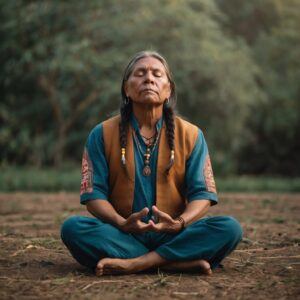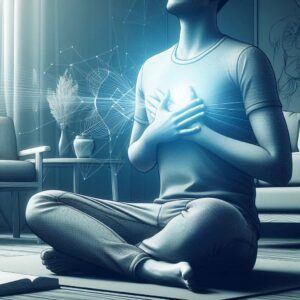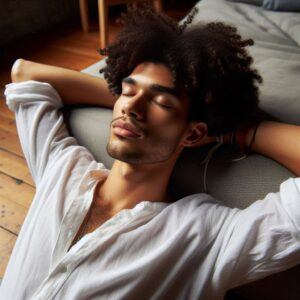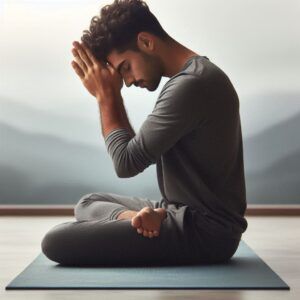A) Best Meditation Techniques for Anxiety

Anxiety is a prevalent issue in today’s fast-paced world, affecting millions of people globally. According to the World Health Organization, approximately 264 million people worldwide suffer from anxiety disorders. Managing anxiety effectively is crucial for maintaining mental and physical well-being. One powerful method for reducing anxiety is meditation. This article explores the best meditation techniques for anxiety, backed by research and expert recommendations.
Mindfulness Meditation
Mindfulness meditation is one of the most popular and effective techniques for managing anxiety. This practice involves paying full attention to the present moment without judgment. By focusing on the here and now, mindfulness meditation helps individuals become aware of their thoughts and feelings without becoming overwhelmed by these thoughts and feelings.
Benefits and Techniques
Mindfulness meditation can significantly reduce symptoms of anxiety. A study published in the journal JAMA Internal Medicine found that mindfulness meditation programs can improve anxiety, depression, and pain. Participants in the study who practiced mindfulness meditation experienced a moderate improvement in anxiety symptoms compared to those who did not practice mindfulness.
To practice mindfulness meditation:
1. Find a quiet and comfortable place to sit.
2. Close your eyes and take deep breaths.
3. Focus on your breathing and observe each inhale and exhale.
4. Notice your thoughts and feelings without judgment, gently bringing your focus back to your breath if your mind starts to wander.
Deep Breathing Exercises

Deep breathing exercises are simple yet powerful techniques that can help calm the mind and body. These exercises focus on controlling your breath to activate the body’s relaxation response, which can lower anxiety levels.
Benefits and Techniques
Deep breathing can reduce the physical symptoms of anxiety, such as rapid heart rate and shortness of breath. According to Harvard Health Publishing, deep breathing exercises can help reduce stress and promote relaxation.
To practice deep breathing exercises:
1. Sit or lie down in a comfortable position.
2. Place one hand on your chest and the other on your abdomen.
3. Inhale deeply through your nose, allowing your abdomen to rise.
4. Exhale slowly through your mouth, letting your abdomen fall.
5. Repeat for several minutes, focusing on your breath and the rise and fall of your abdomen.
Body Scan Meditation Sleep

Body scan meditation is a technique that involves systematically focusing on different parts of the body, and noticing any sensations or tension. This practice promotes relaxation and can help reduce physical symptoms of anxiety and even induce sleep.
Benefits and Techniques
Body scan meditation can improve overall awareness of bodily sensations and reduce stress. A study published in the journal Behaviour Research and Therapy found that body scan meditation can significantly reduce symptoms of anxiety and depression in participants.
To practice body scan meditation:
1. Lie down in a comfortable position with your eyes closed.
2. Start by focusing on your toes and noticing any sensations.
3. Slowly move your attention up your body, focusing on each part and releasing any tension that may be present.
4. Continue this process until you reach the top of your head.
Guided Imagery

Guided imagery involves visualizing calming and peaceful scenes or experiences. This technique can distract the mind from anxious thoughts and promote a sense of tranquility.
Benefits and Techniques
Guided imagery can be particularly effective for reducing anxiety and promoting relaxation. A study published in the journal The Arts in Psychotherapy found that guided imagery can significantly reduce anxiety levels in participants.
To practice guided imagery:
1. Find a quiet place to sit or lie down.
2. Close your eyes and take deep breaths.
3. Visualize a peaceful scene, such as a beach or forest.
4. Imagine yourself in that scene, engaging all your senses to make the visualization as vivid as possible.
Loving-Kindness Meditation
Loving-kindness meditation (Metta) focuses on developing compassion and love towards oneself and others. This practice can help reduce self-criticism and promote emotional well-being.
Benefits and Techniques
Loving-kindness meditation can improve positive emotions and reduce symptoms of anxiety and depression. A study published in Psychology Today found that loving-kindness meditation can increase positive emotions and reduce symptoms of anxiety.
To practice loving-kindness meditation:

1. Sit in a comfortable position with your eyes closed.
2. Take deep breaths and focus on your heart center.
3. Repeat phrases such as “May I be happy, May I be healthy, May I be safe” while focusing on yourself.
4. Gradually extend these wishes to others, starting with loved ones and eventually including all beings.
Transcendental Meditation
Transcendental meditation involves the repetition of a mantra to help the mind settle into a state of restful alertness. It has been shown to reduce stress and anxiety significantly.
Benefits and Techniques
Transcendental meditation can lead to a deep state of relaxation and reduced stress. A study published in the journal Lancet Psychiatry found that transcendental meditation can significantly reduce symptoms of post-traumatic stress disorder (PTSD) and anxiety in veterans.
To practice transcendental meditation:
1. Sit comfortably with your eyes closed.
2. Silently repeat a mantra, a word or phrase, for 20 minutes.
3. Allow your mind to settle into a state of mind where the brain functions more coherently while the body rests deeply. This is known as “restful alertness”.
Movement-Based Meditation
Movement-based meditation, such as yoga and Tai Chi, combines physical activity with mindfulness. These practices can help reduce anxiety by promoting physical relaxation and mental focus.
Benefits and Techniques
Movement-based meditation can improve both physical and mental health. A study published in the journal Frontiers in Psychiatry found that yoga can significantly reduce anxiety symptoms and improve overall well-being.
To practice movement-based meditation:
1. Choose a form of movement-based meditation, such as yoga or Tai Chi.
2. Focus on your breath and movements and stay present in the moment.
3. Practice regularly to experience the full benefits.
Conclusion
Incorporating these meditation techniques into your daily routine can be highly beneficial in managing anxiety, promoting a sense of calm, and improving overall mental health. Each technique offers unique benefits, so it’s important to find the one that works best for you. By practicing mindfulness meditation, deep breathing exercises, body scan meditation, guided imagery, loving-kindness meditation, transcendental meditation, and movement-based meditation, you will be able to take control of your anxiety and enhance your well-being.
By following these meditation practices and incorporating them into your life, you can effectively manage anxiety and lead a more peaceful, balanced life.
B) Yoga Body Scan Meditation
Combining the physical benefits of yoga with the mental tranquility of body scan meditation creates a powerful practice for alleviating anxiety. Yoga body scan meditation involves performing gentle yoga poses while simultaneously focusing on different parts of the body, and noticing any sensations or tension. This integrated approach enhances relaxation and mindfulness, providing a holistic method for reducing anxiety.
The practice begins with selecting a series of gentle yoga poses, such as Child’s Pose, Cat-Cow Stretch, and Savasana. These poses are designed to relax the body and prepare it for deeper meditation. As you move through each pose, take the time to perform a body scan, starting from the toes and working your way up to the head. Focus on each part of the body, noticing any areas of tension or discomfort, and breathe into those areas to release the stress. This dual focus on physical movement and mindful awareness can help quiet the mind and ease anxiety symptoms.

Research supports the effectiveness of combining yoga and body scan meditation. A study published in the Journal of Clinical Psychology found that participants who practiced yoga combined with body scan meditation experienced significant reductions in anxiety and improved overall mental health. The gentle movements of yoga help release physical tension, while the body scan meditation enhances mindfulness and promotes a state of calm.
Incorporating yoga body scan meditation into your daily routine can provide lasting benefits for anxiety management. By dedicating just 20-30 minutes each day to this practice, you can create a powerful ritual that supports both physical and mental well-being. This holistic approach not only effectively manages anxiety but also improves flexibility, reduces muscle tension, and enhances overall mindfulness, making it an essential addition to any wellness routine for better mental health and physical well-being.

